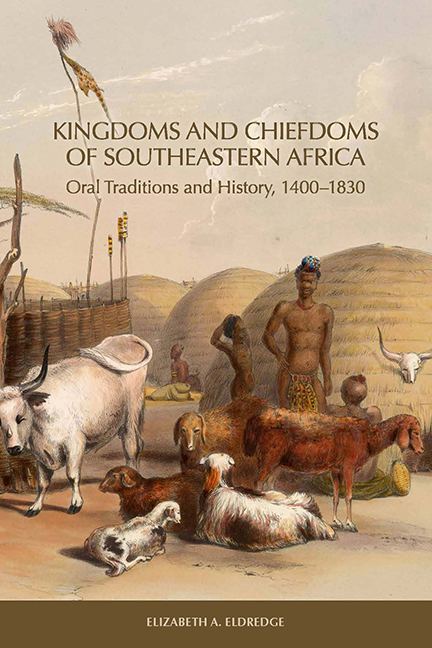Book contents
- Frontmatter
- Contents
- List of Illustrations
- Preface
- 1 History and Oral Traditions in Southeastern Africa
- 2 Oral Traditions in the Reconstruction of Southern African History
- 3 Shipwreck Survivor Accounts from the Sixteenth and Seventeenth Centuries
- 4 Founding Families and Chiefdoms East of the Drakensberg
- 5 Maputo Bay Peoples and Chiefdoms before 1740
- 6 Maputo Bay, 1740–1820
- 7 Eastern Chiefdoms of Southern Africa, 1740–1815
- 8 Zulu Conquests and the Consolidation of Power, 1815–21
- 9 Military Campaigns, Migrations, and Political Reconfiguration
- 10 Ancestors, Descent Lines, and Chiefdoms West of the Drakensberg before 1820
- 11 The Caledon River Valley and the BaSotho of Moshoeshoe, 1821–33
- 12 The Expansion of the European Presence at Maputo Bay, 1821–33
- 13 Southern African Kingdoms on the Eve of Colonization
- Appendix A Ama Swazi King Lists
- Appendix B Chronology of Conflicts, Migrations, and Political Reconfiguration East of the Drakensberg in the Era of Shaka
- Appendix C Interviewees from the James Stuart Collection of Oral Traditions
- Notes
- Bibliography
- Index
6 - Maputo Bay, 1740–1820
Published online by Cambridge University Press: 14 March 2018
- Frontmatter
- Contents
- List of Illustrations
- Preface
- 1 History and Oral Traditions in Southeastern Africa
- 2 Oral Traditions in the Reconstruction of Southern African History
- 3 Shipwreck Survivor Accounts from the Sixteenth and Seventeenth Centuries
- 4 Founding Families and Chiefdoms East of the Drakensberg
- 5 Maputo Bay Peoples and Chiefdoms before 1740
- 6 Maputo Bay, 1740–1820
- 7 Eastern Chiefdoms of Southern Africa, 1740–1815
- 8 Zulu Conquests and the Consolidation of Power, 1815–21
- 9 Military Campaigns, Migrations, and Political Reconfiguration
- 10 Ancestors, Descent Lines, and Chiefdoms West of the Drakensberg before 1820
- 11 The Caledon River Valley and the BaSotho of Moshoeshoe, 1821–33
- 12 The Expansion of the European Presence at Maputo Bay, 1821–33
- 13 Southern African Kingdoms on the Eve of Colonization
- Appendix A Ama Swazi King Lists
- Appendix B Chronology of Conflicts, Migrations, and Political Reconfiguration East of the Drakensberg in the Era of Shaka
- Appendix C Interviewees from the James Stuart Collection of Oral Traditions
- Notes
- Bibliography
- Index
Summary
After the departure of the failed Dutch trading post in 1730, the political contests and occasional military engagements among the Maputo Bay chiefdoms that had so disrupted trade appear to have persisted, driven at least in part by rivalries over succession to chieftaincies. During the 1720s the heir to the Tembe chieftaincy, Modammadom, was still a minor, and his uncle, Nwangobe, served as ruling regent. When he reached adulthood Modammadom had to use force to drive out Nwangobe, who refused to step aside voluntarily, as was expected, for the legitimate heir. Nwangobe took refuge with Inyaka chief Machavane east of the Maputo River, from where he launched sporadic attacks against the AmaTembe, now under Modammadom's rule. Eventually by the 1750s the older man, Nwangobe, had defeated his nephew, the legitimate heir Modammadom. In the midst of this turmoil, in 1747 some Maputo Bay chiefs sent a joint message to the Portuguese post at Inhambane requesting the Portuguese resume their previous biennial trade voyages, evidently because it had been so long since any traders had visited the bay. In the meantime Nwangobe turned against his former host Machavane and defeated him, subsuming the territory east of the Maputo River, that of the two Inyaka chiefdoms, under the Tembe chieftaincy.
In spite of their claims of imperial rights over southern Mozambique, including Maputo Bay and the trade there, the Portuguese were never able to assert control there in the eighteenth century. Instead, in the Inhambane and Maputo Bay regions shifting configurations of chiefdoms continued to operate independently under shifting alliances and drew on the benefits of trade that remained in the hands of traders known for their cultural origins in India and the Muslim Swahili coast. InfLuences from the Swahili coast ports, including the Islamic religion, filtered down to Inhambane through trade and traders. Competition increased for control over the vicinity of Inhambane between Tonga chiefs, including the important chiefdoms of Tinga-Tinga, Nhamussa, Chamba, and Nhampossa, who were required by the Portuguese to provide labor and defense and to allow the free fLow of trade goods through their territory to the Portuguese.
- Type
- Chapter
- Information
- Kingdoms and Chiefdoms of Southeastern AfricaOral Traditions and History, 1400–1830, pp. 135 - 153Publisher: Boydell & BrewerPrint publication year: 2015

